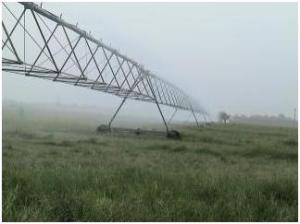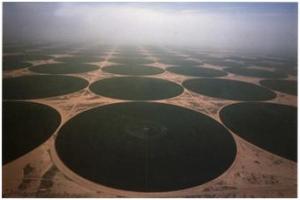Thirty years of water utilisation improvements in Saudi Arabia
In 1977 there was one modern center pivot in Saudi Arabia. There are now probably around 45,000 operational machines irrigating around 1.3 million hectares.
 The 33 year journey from the very small beginning to one of the largest concentrations of center pivots in the world has charted the improvements in modern irrigation techniques.
The 33 year journey from the very small beginning to one of the largest concentrations of center pivots in the world has charted the improvements in modern irrigation techniques.
In ’77 the predominant Saudi irrigation system was flood which, even when well done, probably makes effective use of only 40% of the available water. The center pivot of the late ‘70s, even with it’s many weakness improved this to probably 60% usage (a 50% increase in water use over flood), still 40% was lost to evaporation, run-off, deep seepage and evaporation from the crop canopy.
 Other techniques were also tried in the late ‘70s and early ‘80s – wheel-lines with impact sprinklers were better than flood but not as good as the center pivot. Big guns were also tried but the effect of the soil of the impact of big droplets, coupled with wind distortion of the spray pattern and very high evaporation losses soon made the system unattractive.
Other techniques were also tried in the late ‘70s and early ‘80s – wheel-lines with impact sprinklers were better than flood but not as good as the center pivot. Big guns were also tried but the effect of the soil of the impact of big droplets, coupled with wind distortion of the spray pattern and very high evaporation losses soon made the system unattractive.
The center pivot slowly evolved from the simple system of ‘77 with high level impact sprinklers mounted above the pipe using quite high pressures and only the nozzle size to control application rate. Firstly the impact sprinklers were replaced with nozzles and spreader plates and mounted under the pipe on short drop pipes.
This improved recovery of water and reduced pumping costs. To further reduce evaporation losses the short drop pipes increased in length placing the nozzles close to height of the crop being irrigated.
This further reduced evaporation losses because the distance to the target was much less. The major breakthrough of this time, around ’89, came with the introduction of pressure regulators on each nozzle.
This separated the effect of pressure drop along the possibly 500 metre length of pipeline from the size of the nozzles, now the nozzle in the center had the same pressure (15 psi) as it’s much larger companion 500 metres further out at the end of the pipe. This largely eliminated pressure variations due to pump wear, resistance due to corrosion , drop of the aquifer during peak season use, etc.
 The result of this huge expansion, not only in area but in efficient use of water has been to allow Saudi Arabia, which thirty years ago was predominantly dependent on imports to develop an agriculture which allows self-sufficiency in many important foodstuffs both crops and livestock. Many of the farms are now huge by any measure of judgement with dairy companies reaching over 65,000 head in milk with average yields around 12,500 litres. Many farms are now double cropping wheat and maize and achieving 9+ tons of wheat and 14 tons of maize; over 23 tons of cereals/ha/year.
The result of this huge expansion, not only in area but in efficient use of water has been to allow Saudi Arabia, which thirty years ago was predominantly dependent on imports to develop an agriculture which allows self-sufficiency in many important foodstuffs both crops and livestock. Many of the farms are now huge by any measure of judgement with dairy companies reaching over 65,000 head in milk with average yields around 12,500 litres. Many farms are now double cropping wheat and maize and achieving 9+ tons of wheat and 14 tons of maize; over 23 tons of cereals/ha/year.
The scarcity of water has driven the very rapid introduction of the most modern techniques to maximise the utilization of the scarce underground water resources. These techniques continue to be refined and adapted to the extreme conditions and it is expected that even more efficient use will be made of water; the country’s scarcest resource.
 All these improvements have come together into the Lower Energy Precision Application – LEPA – system which especially for row crops, allows very low level application at even lower pressures with almost no crop canopy wetting, much better control of infiltration rates, minimal evaporation losses and even further reduced pumping costs. New advances are being introduced all the time and the drag-hose system, which is effectively a moving drip irrigation system, even further refines and increases the efficiency of water usage. These advances have brought water utilisation efficiency much closer to the theoretical maximum of 100%.
All these improvements have come together into the Lower Energy Precision Application – LEPA – system which especially for row crops, allows very low level application at even lower pressures with almost no crop canopy wetting, much better control of infiltration rates, minimal evaporation losses and even further reduced pumping costs. New advances are being introduced all the time and the drag-hose system, which is effectively a moving drip irrigation system, even further refines and increases the efficiency of water usage. These advances have brought water utilisation efficiency much closer to the theoretical maximum of 100%.
About the author:
Mr Lawton was educated in Agriculture at Seale-Hayne College in Devon and subsequently taught there for three years. He worked for 10 years in ICI agricultural division, mainly based in the Head office at Billingham in the Farm Advisory Service. In 1977 Mr Lawton started working in Saudi Arabia for Masstock (now Almarai) developing the Faisal Settlement Organisation farm at Haradh. The original flood irrigation was replaced by 200 center pivot irrigators. In 1980 he started work with Alkhorayef Sons Co as sales and farms manager. Valley Center Pivot sales developed within 5 years to become the world’s largest Valley agent, selling more than 2,500 units per year. Private farms totalling 178 centre pivots were developed growing crops ranging from wheat, barley, maize, onions, potatoes, sorghum, alfalfa and Rhodes grass. In 1985 Mr Lawton joined Golden Grass Inc developing agrochemical sales and a large private farm In Hail. Since 1991 Mr Lawton has worked in farm management and sales of farm equipment, mainly Alvan Blanch feed and grain processing installations and Supreme TMR mixers from Wetaskiwin, Canada. In 2008 Agricultural Technology was formed which is a Saudi based 100% foreign capital services company supporting the installation and commissioning of Alvan Blanch and Supreme equipment in Saudi and the neighbouring GCC countries.








Leave a comment